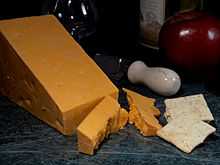Red Leicester
| Red Leicester | |
|---|---|
 | |
| Other names | Leicester |
| Country of origin | England |
| Region | Leicestershire |
| Source of milk | Cows |
| Texture | Hard |
| Fat content | 33% total (48% as FDM) |
| Aging time | 4–9 months |
Red Leicester (also known simply as Leicester or Leicestershire Cheese[1]) is an English cheese, made in a similar manner to Cheddar cheese, although it is crumblier. Since the 18th century, it has been coloured orange by adding annatto extract during manufacture.[2] It is a cow's milk cheese, originally from Leicestershire, England, and is named after the city of Leicester. It has a firm texture, and a slightly nutty taste. Versions sold in supermarkets are typically made with the added ingredient annatto, which is used as a food colouring, although it is possible to obtain Red Leicester without annatto.
Although Red Leicester can be young or "old", aged anywhere from four to nine months, the young Leicesters at the start of that range will be very mild: they often require at least six months to develop a tang. Farmhouse versions are also available. Farmhouse makers will mature it in cloth, the old way, to allow better flavour development. Versions of Red Leicester are also made in North America.[citation needed]
History
The cheese was originally made on farms in Leicestershire with milk that was surplus once all the Stilton desired was made. It was originally coloured with carrot or Beet juice.
It used to be called Leicestershire Cheese, after the county in which it was originally made, but is now called Red Leicester to distinguish it from the White Leicester which was made to a national recipe under wartime controls during the 1940s.[3] The rind is reddish-orange with a powdery mould on it.
The fat content of Red Leicester cheese when fresh is generally between 33 and 34%. Regulations regarding cheese require minimum fat levels to be stated in terms of the "fat in dry matter" or FDM, as moisture levels decrease as cheese ages. Take out the moisture and you are left with fat, protein, minerals, vitamins and salt – the FDM measures the amount of fat in these solids, exclusive of water. So although the minimum FDM generally listed for Red Leicester is 48% this equates to an actual fat content in the final product of around 33–34%
References
- ↑ "BBC - Food - Red Leicester". BBC Online. Retrieved 7 May 2013.
- ↑ http://www.britishcheese.com/redleicester/history_of_red_leicester-38 History of Red Leicester
- ↑ British Cheese Board